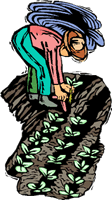Panhandle Plantings-A new column by Master Gardener Val Ford

"You ought to know that October is the first Spring month."
-- Karel Capek, The Gardener's Year
For those of us transplanted to Northwest Florida from "up north," autumn is virtually like a breath of spring air. Vegetables associated with springtime in cooler climates – broccoli, beets, brussels sprouts, lettuces, onions, spinach, strawberries, dill, cilantro -- are "cool season" vegetables to be grown here throughout the fall and winter.
Permanent warm-season grass maintenance is ended for the year; no fertilization is required until March. Late October to mid-November is the optimal time for over-seeding rye grass (both Perennial/English ryegrass - Lolium perenne - and Annual/Italian ryegrass - Lolium multiflorum - are annuals in our area) for winter lawns. Once the lawn becomes established, about the time of the second mowing, you should apply ˝ pound of nitrogen fertilizer per 1,000 sq. ft. using a complete formulation such as 6-6-6.
Here's the tricky part – not only are you irrigating and fertilizing the winter lawn, but also the dormant permanent warm-season grass. Quite unintentionally you’re creating a favorable short-term environment for ryegrass while developing a potentially stressful environment for your permanent lawn. Unfortunately the results of this dichotomy aren't always obvious until late spring and are often mistaken for insect damage.
With cooler weather we begin seeing "spring" flowers – petunias, pansies, snapdragons, violas, nasturtiums (protect from frost!), dianthus. Now is the time to begin thinking about trees and shrubs to be added to the landscape. Plan now for transplanting in January.
Fall color is always an important issue this time of year, and the Popcorn Tree (a. k. a. Chinese Tallow Tree – Sapium sebiferum) is one of our primary sources of bright reds and oranges. The only problem is that it’s a highly invasive species -- so much so that sale of the tree was banned in Florida, by law, as of January 1, 1998. Homeowners are encouraged to remove trees from the landscape whenever possible, to prevent further spread into "wild" areas. During the fall, when seeds are present, the quickest and most efficient method of removing a tree is with a basal bark application of a Garlon 4/mineral oil mixture.
For more information about establishing a winter ryegrass lawn, reference a copy of "Over-seeding Florida Lawns for Winter Color." Information about the Chinese Tallow Tree, its removal and replacement alternatives, can be found in "Natural Area Weeds: Chinese Tallow" (SS-AGR-45). Both pamphlets are available from your local Extension Office, or go to http://edis.ifas.ufl.edu/ to access them online.
WORDS OF WISDOM: Much rain in October, much wind in December. A warm October, a cold February. Full moon in October without frost, no frost ‘till November's full moon.
Val Ford is a Holmes County Master Gardener. She is a three-time recipient of the Florida MG Award for Written Mass Communications for the weekly DeFuniak Springs Herald "Gardeners’ Dirt" column. If you have gardening questions or problems, contact your local County Extension Office, or Val at Flsnowflake7592@aol.com.
Page created and maintained by West Florida Electric Cooperative, Inc. © 2001.
designed by embryo design